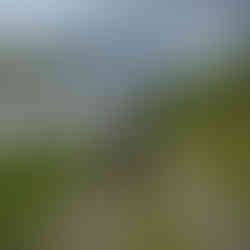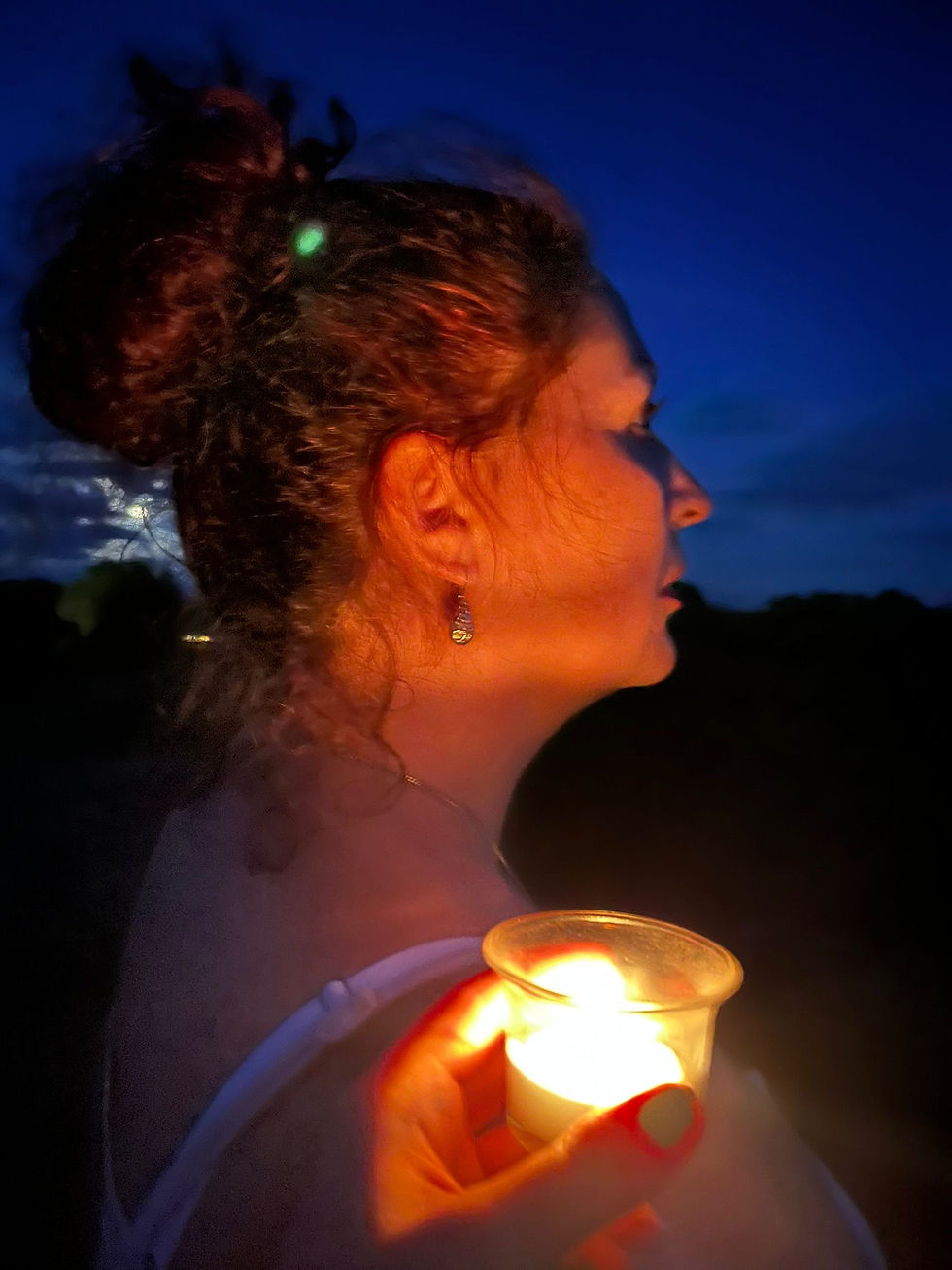Pilgrimage to the Cailleach
- living-in-full-blo
- Jul 22
- 6 min read
It began the evening before, in the soft amber light of a quiet Monday in Weem. We were tucked away in a little stone cottage just outside Aberfeldy, the kind of place where the world feels slower, older—closer to the stories whispered by the land. I reminded John of the place I had longed to visit ever since first hearing about it in Hagitude by Sharon Blackie. Tigh nam Bodach—the house of the Cailleach and her kin. A sacred site hidden in the folds of Glen Cailliche, shrouded in mystery and old magic. It had lodged in my mind like a forgotten dream.
On Tuesday morning, we wandered into Aberfeldy, a sweet, unhurried town that seemed to welcome us gently. As we gathered supplies and provisions, my eyes caught a little shop called Munro’s. Something nudged me—intuition, curiosity, maybe reverence—and I stepped inside, searching for a map. I asked, as carefully as I could, if they had an Ordnance Survey of Loch Lyon. I’d read that locals were protective of the site, rightly so; the stones had been disrespected by careless visitors, disturbed and defaced. I didn’t want to be seen as another intruder. But the man behind the counter was kind, sharp-eyed but warm. He handed me the right scale map and warned me, not unkindly, of the challenges ahead: a steep climb early on, and a river ford that could be treacherous if the hills had seen recent rain. His words felt like a blessing and a warning, as all good tales begin.
With the map in hand, I told John we could make it. That I needed to make it. The pull was deeper than desire—it was a summons. We picked up a few forgotten essentials—a new rucksack and boots for me—and stocked up on food and drink for the journey, including treats for our dog, Bodhi.
That evening, we studied the route our fingers tracing the lines of the glen on the map, We cooked Aberdeen Angus rump steak from the village butcher, hearty and grounding, and packed our bags before settling in for an early night. The forecast promised dry weather—a rare, almost miraculous gift in this part of Scotland—and I felt a quiet blessing in the stillness outside our window.
We woke at seven. Bacon and egg sandwiches for breakfast, strong coffee for me, and John with his usual super-strength, no-sugar tea. As we dressed, I noticed John pulling on jeans, and I gently reminded him of my short but dramatic time bushwalking in Tasmania and doing Duke of Edinburgh treks—jeans were a terrible idea. He eventually, and comically, opted for my leggings with a pair of shorts over the top. I took a photo of his mismatched outfit, laughing at how completely unprepared yet perfectly himself he looked.
We piled into the van, Bodhi nestled in the back, and drove past the ancient yew tree in Fortingall—5,000 years of life still standing. The road narrowed into a single track, tracing the river Lyon as it rushed beside us, dark water tumbling over rocks like spilled secrets. We passed a herd of young stags, their antlers catching the morning light like antennae tuned to older realms, and a red squirrel disappeared into the bracken, all flame and flicker. Glenlyon Primary school briefly emerged on our right, paying steward to young minds with bright futures, unconcerned with our passing. A cluster of highland cows blocked the road ahead—stoic mothers and calves, and a hulking bull eyeing us with casual dominance. We were relieved to be safely inside the van, although John fretted aloud about horns and van panels. Then came a curious sight: a mobile phone mast disguised, poorly, as a tree.
At last, the road led us to Loch Lyon and the dam that held back its shimmering waters. We parked respectfully by some barns, careful not to obstruct any farm vehicles. The time was 10:10.
The walk began with a locked gate and a flurry of swearing as we tried to hoist Bodhi over it. It was a shaky start. Bodhi, who had never seen sheep before, turned wild—barking, pulling, hopping sideways like a spring-loaded goat. He ignored chicken treats, ignored us, his lead tangling us like a maypole dance gone wrong. The first stretch was punishing. Up and down along the uneven trail, sheep carcasses decaying in shadowed gullies, the weight of their absence lingering in the air. We were frustrated, tired, our patience fraying like old rope.
Still, in those raw moments, beauty revealed itself. A single iridescent beetle—a dung beetle perhaps—crossed the trail, gleaming like a jewel in the dirt. And just when we questioned our resolve, we reached the halfway point—a waterfall tumbling with silver light. It was here we had agreed to turn back if the walk proved too much. But something shifted. The land opened. The trail softened, flatter now, and the loch stretched beside us, vast and serene. Tiny waterfalls braided the slopes, white ribbons tumbling to our right. With Bodhi now clipped to just his harness—no collar tugging at his neck—he softened too. He walked with us, more companion than chaos.
The glen became quiet and wide, brimming with possibility. We crossed two more gates, lifting Bodhi gently, and turned with the loch toward a ‘dog-leg’ bend, where the river fed into the water. A turn screeched on an outcrop —a loud guardian of a hidden nest. Then came the ford. I tried to skip across the larger stones, determined to keep my boots dry, but Bodhi had other ideas—bounding through the water like a joyful storm, nearly dragging me down with him. Soaked feet, but a dry laugh. John followed with more dignity.
Then—disaster—we realised the map was gone. John had, earlier, tucked it under a strap and worn it like a learner’s plate as a joke. Now it was lost, possibly abandoned back at the gate during our Bodhi-lifting antics. We hesitated but decided to continue. The man at Munro’s had said the stones were only twenty minutes beyond the ford.
The path narrowed and climbed again, now less used, noisier. The air changed. The soundscape shifted from loch to river—fast, urgent, alive. The wind moved over the rocks in long, whispering breaths, rising and falling like the echo of a song, as if the glen itself was humming some ancient lullaby only the stones could understand. We were no longer just walking. We were entering something. A cradle between two mountains opened before us, and suddenly, there they were.
The stones.
At first, I was startled. They weren’t how I’d imagined them—neatly arranged outside a turf-roofed house. Instead, a small stone structure rose humbly from the earth, flanked by skulls and bones. The air held its breath. Bodhi lunged toward the bones, and John held him back. I was momentarily repulsed, even afraid. But then I understood. These were offerings. Tributes. Others, like me, had brought something meaningful. I placed the two stones, one beautiful white sparkling and one yellow like amber, that I’d chosen from a waterfall on route, on to the roof and whispered quiet blessings for loved ones.
We stepped back. We sat on a nearby rock, heart full, hands warm around a jet boil coffee. We shared cheese sandwiches and a KitKat Chunky while Bodhi rested, finally still. It was 1:10—three hours since we’d begun. The shrine stood a short distance away, timeless and unwavering, while Bodhi chewed calmly on the bog grass. The contrast struck me deeply: our young, riotous dog, full of bark and bounce, lying in the ancient shadow of the Cailleach—the old woman of winter, goddess of the mountains and storms, resting now in summer’s lull.
I told John the stories—the stones are brought outside each Beltane so they may bask in the warmth of the sun. On Samhain, they’re taken back inside, sheltered once more. Some say the Cailleach becomes Brigid in summer, that this ancient goddess changes her face with the seasons. Perhaps. Or perhaps she is all things—storm and seed, snow and fire.
After an hour, we began our return. We said our farewells to the Cailleach, to Bodach—her consort—and their kin. I pointed out what I believed to be each including their daughter’s stone, smaller but no less proud.
Back over the ford, back through the gates, past the turn’s watchful cry—and there it was. The map. Lying in the track, waiting for us as if no time had passed.
We paused again not far from the waterfall for tea, and with signal returning, called the children. William was working, so we sent a video of the glen. EllaMae answered with Jaume, and we shared the view, the sheep skulls, and our surreal coffee stop by the shrine.
The final mile stretched before us—up and down once more. The midges descended in clouds, relentless and biting. We stumbled into the van at 5:25pm, breathless and elated.
As we drove back, Bodhi snored in the crate. We passed the same highland cows, the same now solitary school, the same stags’ field, now empty. No red squirrel this time. Just the steady hum of reflection.
Back at the cottage by 8pm, we opened a bottle of whisky and toasted the Cailleach and her Bodach. Not as visitors, but as pilgrims. Changed. Humbled. Grateful.





























Comments